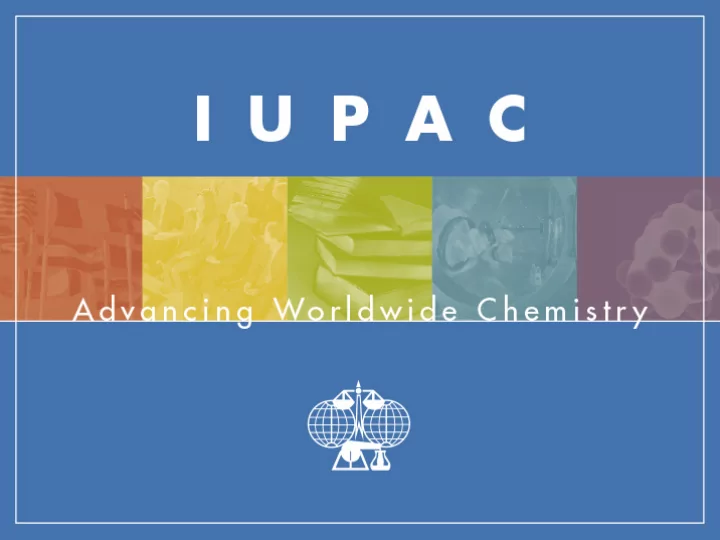

IUPAC’s mission is to advance the worldwide aspects of the chemical sciences and to contribute to the application of chemistry in the service of Mankind. • Promotes norms, values, ethics of science • Advocates free exchange of scientific information and access of scientists • Addresses global issues as a scientific, international, non-governmental, objective body
IUPAC Member Countries 49 National Adhering Organizations (NAOs) 19 Associate National Adhering Organizations (ANAOs)
IUPAC Organization Divisions and Standing Committees manage IUPAC's scientific work • Physical & Biophysical Chemistry • Inorganic Chemistry • Organic & Biomolecular Chemistry • Polymer • Analytical Chemistry • Chemistry & the Environment • Chemistry & Human Health • Chemical Nomenclature & Structure Representation • Committee on Chemistry and Industry (COCI) • Committee on Chemistry Education (CCE) • CHEMRAWN Committee • Committee on Printed and Electronic Publications (CPEP)
Major IUPAC Activities • Development of the Language of Chemistry – Nomenclature, Symbols, Terminology • Standardization of Chemistry Methods – Data Presentation, Study of Analytic Methods • Critical Evaluation of Physico-Chemical Data – Atomic Weights, Thermodynamic Data, Kinetic Data • Data Exchange Standards for Computers and Instruments • Sponsorship of Conferences • Chemistry Education • Industrial Safety and Environmental Programs • CHEMRAWN Conferences addressing Chemistry and Societal Impact
IUPAC/OPCW International Workshop: Impact of Advances in Science and Technology on the CWC • 22-25 April, 2007 in Zagreb, Croatia • 68 participants from 30 countries • Sessions included: – Context of the Chemical Weapons Convention – Trends in the chemical industry – Developments in chemical synthesis, analysis and production – Advances in fields such as nanotechnology and decontamination technology – Expert commentary on the presentations and break-out discussion sessions • Report published in Pure and Applied Chemistry, Vol. 80, No. 1, pp. 175–200, 2008.
Workshop Findings and Conclusions Divided into Five Categories: • Technical challenges to the CWC • Technical challenges relating to the implementation of the CWC • Protection against the effects of chemical weapons • Opportunities in the field of international cooperation • Awareness-raising, education, and outreach
Workshop Proposals to the OPCW • Additional efforts to ensure national implementation of the CWC, especially with regard to the General Purpose Criterion • Agreement on the need for declaration of toxic chemicals held by States Parties for law enforcement • Further enhancement of verification • Further development of OPCW analytical capabilities, including capability to analyze toxins and biomedical samples • Inclusion of relevant nonscheduled chemicals in analytical database • Training of chemists, particularly in the developing world, in the use of these analytical methods and equipment • Strengthening linkages and collaboration with other international treaties and mechanisms related to managing chemicals and minimizing their adverse impacts
Chemical Weapons Convention: Educational and Outreach Challenges • Ownership – “CWC is someone else’s responsibility” • Concerns of negative impact on public image of chemistry • Knowledge base of chemistry teachers at all levels about the issue • Little formal attention to ethical issues in curriculum • Remoteness of CWC structure to educational system
Multiple Uses of Chemicals A Chemical Plant
Multiple Uses of Chemicals A Chemical Plant
Misuse of Chemicals ephedra extracts banned as diet supplements in several countries Triple Stack E pehedra C affeine A spirin (ASA)
CH 3 OH CH 3 CH 2 CH NH CH 3 CH CH NH CH 3 methamphetamine pseudoephedrine (crystal meth) (cough suppressant)
Production of Crystal Meth
Export Industry
Multiple-Use Chemicals • Choices about the beneficial use, misuse, or abuse of these multi-use materials lie in our hands.
Role for Science Education? Break-Out Session • Access to information • Diversion of readily available materials • Whose responsibility? • Understanding and owning ethical responsibility • Other examples
Chemical & Biological Weapons HOCH 2 CH 2 S CH 2 CH 2 OH ClCH 2 CH 2 S CH 2 CH 2 Cl thiodiglycol mustard gas Organization for Prohibition of Chemical Weapons Water-based dyes in cloth manufacturing industry, including rural industries in developing countries
Chemical and Biological Weapons: Role for Science Education ? • Access to information • Diversion of readily available materials • Whose responsibility? • Understanding and owning ethical responsibility • Other examples
Where we are now • Project complete • http://www.iupac.org/multiple-uses-of- chemicals • Material – text and pictures • Also 4 background papers in 6 languages • Room for more • Comments welcome! – Alastair Hay (a.w.m.hay@leeds.ac.uk) – Peter Mahaffy (peter.mahaffy@kingsu.ca)
Recommend
More recommend